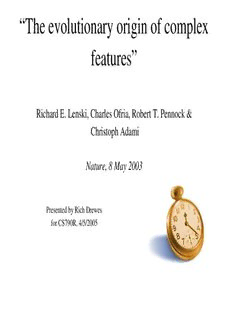
“The evolutionary origin of complex features” Richard E. Lenski PDF
Preview “The evolutionary origin of complex features” Richard E. Lenski
“The evolutionary origin of complex features” Richard E. Lenski, Charles Ofria, Robert T. Pennock & Christoph Adami Nature, 8 May 2003 Presented by Rich Drewes for CS790R, 4/5/2005 Simulating evolution Model features 26 instructions, only one logic function (NAND) ● Sequential processing, plus jumps ● Asexual reproduction ● Mutation only, no crossover ● Start with organisms that have copy ability, but no logic ● function ability Organisms get energy by doing multi-step logic functions ● Fitness rewards Phylogenetic depth Fitness trajectories Surprisingly, some mutations in the lineage of the eventual dominant genotype were deleterious (two even reduced fitness by >50% temporarily) Were these deleterious mutations essential or incidental? By replaying history, they were found to be essential! Functional-genomic array Chart is for first EQU organism. Top row, red means can't do this function, green means can. Inside chart, red means effect of NOP'ing that instruction. Many interacting components for the complex functions— remove any one element, and the complex functions break. Building blocks “Reward All Simpler Functions”: 46% found EQU “Reward All But One Two Simpler Function”: 34% found EQU “Reward None”: 0% found EQU Conclusions Incremental increased fitness for “steps” is essential for evolution ● of more complex features. For populations with no fitness for subfunctions, “...none of these populations evolved EQU...” and incremental increased fitness for building blocks is “...precisely what evolutionary theory requires...” Complex features depend on the delicate interaction of many ● elements. But they do occur! No particular intermediate stage was essential ● Evolution not a linear progression; it uses steps backward and ● sideways and makes unexpected use of past incidental creations
Description: